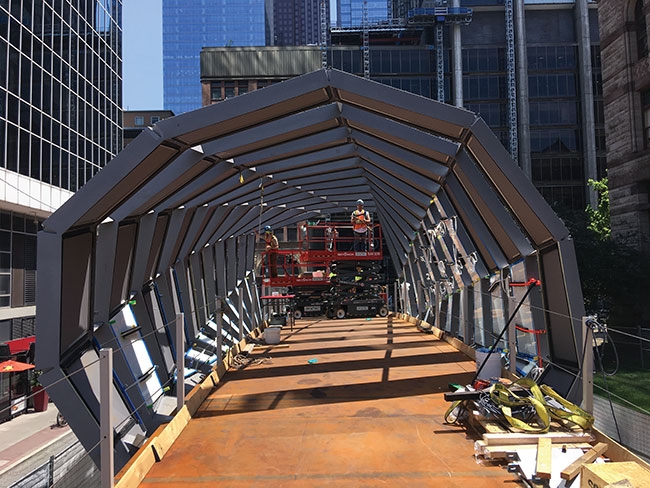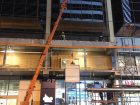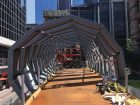
News
Under the Glass: Need more Bass
A small shop lands high-profile projects.
July 31, 2018 By Jack Kohane
 The massive rings on the Eaton Centre’s TEC bridge are installed and Bass workers prepare to install the interior glass. The bridge was partially built on James St. just west of the Eaton Centre and moved into place on July 8, replacing the old bridge between the Eaton Centre and the Bay, over Queen Street.
The massive rings on the Eaton Centre’s TEC bridge are installed and Bass workers prepare to install the interior glass. The bridge was partially built on James St. just west of the Eaton Centre and moved into place on July 8, replacing the old bridge between the Eaton Centre and the Bay, over Queen Street. Look up, up, up at Toronto’s gleaming glass towers and there’s a lot of the Bass Installation team’s handiwork on display. From the lustrous curtainwall and windows of the lofty 72-floor First Canadian Place (BMO Tower), to the 51-storey Bay and Adelaide Centre office skyscraper; and from the luxurious, 68-floor Shangri-La Hotel/Condo spire, to the prestigious Adelaide Hotel (formerly Trump International Hotel and Tower), Bass boasts some of the city’s tallest and architecturally complex structures within its prodigious projects portfolio.
The Mississauga-based glass installation specialist is a top go-to firm when major builders seek the installation of curtainwall, windows, entrances, skylights and revolving doors.
AT A GLANCE | Bass Installation
- Location: Mississauga
- Founded: Oct. 2004
- President: Stephen Callender
- Employees: 30-150 (dependent on projects of various sizes and scope)
- Serves: Mainly GTA
- Focus: Commercial
“We believe we can do it all,” says Stephen Callender, president of Bass Installation. “While our experience has been primarily working in the industrial-commercial-institutional (ICI) market, we are pushing the boundaries to respond for the need of quality unionized installation practices in the high-rise residential market. We are a company that is constantly striving for continuous improvements. We push ourselves to better our installation practices, to improve our safety procedures and to increase our use of technologies.”
In recognition of its accomplishments, Bass was recently awarded the 2018 OGMA (Ontario Glass and Metal Association) Award of Excellence for the University of UTSC (Toronto Scarborough Campus) Environmental Science and Chemistry Building project at the Top Glass conference. “Working with top-notch customers like SotaWall (headquartered in Brampton, Ont., and one of North America’s leading curtainwall suppliers) on unique projects such as the UTSC project is one of the key ingredients to the success of a project,” notes Callender. Bass also earned the 2010 Award for Excellence in Safety Leadership for its work on the Trump International Hotel and Tower project. Callender’s team managed over 20 suspended stages on that monumental structure and it was part of a safety blitz conducted by the Ministry of Labour that year. “It’s a great source of pride for us to win these awards. It’s a testimonial to our excellent safety performance delivered on such prestigious projects that make bold statements in glass.”
Being bold is something Callender and his crew know something about. It wasn’t easy building Bass, subject to the ebb and flow of the unpredictable construction cycle.
Arriving in Toronto from his native Barbados in 1979, Callender started his first job working at a window factory in Scarborough in east-end Toronto. With no prior experience in the glass business, Callender worked his way up in the company by sheer hard work and a savvy knack for using the tools of the trade. Those basic tools have evolved into sophisticated machinery that gets installations done quickly and efficiently at heights of hundreds of metres. Today’s sky-high job sites means Bass’s installation crews rely on an innovative tool kit, primarily DeWalt and Hilti brand power tools, including drills, screw guns, power saws and Wood’s Pow’r suction grips. Installation equipment covers the range of swing stages and Spider Cranes (supplied by Suspended Stages, Scafom Canada and Up and Down Lifting Solutions).
In the early 1980s, he joined the Ironworkers Union (Local 721) and continued working for a variety of companies while completing his apprenticeship. By late 1980s, he became a general foreman for Antamex International (today part of Oldcastle Glass) and ran various key projects in Toronto, including 250 Yonge Street (the Eaton Centre).
Then the recession of 1992 hit. “Like many others in the construction industry, I was laid-off and out of work,” Callender recalls. But he refused to be idle for long. He partnered with a colleague to start their first curtainwall installation company, G+S Associates, where they acquired some small curtainwall, window and revolving door projects throughout the Greater Toronto Area. By 2003, the company changed its name to Bass Installation and the following year Callender became the company’s sole owner. He continued to procure projects such as the William Osler Centre in Brampton, as well as the Canada Life Building and the Bay/Adelaide Centre in Toronto. His entrepreneurially minded daughter, Natasha Callender-Wilson, who graduated the Humber College accounting program in 2007, joined Bass as a business partner and is today its vice-president of business operations and health and safety.
Working from the basement of their family home, Stephen Callender would price jobs by night and manage a growing number of projects by day. Natasha handled the bookkeeping, payroll and health and safety functions while finishing her business degree at York University. In 2010, Bass went into expansion mode, acquiring office and warehouse space in an industrial park area of Mississauga. It continues to acquire additional administrative and operational space as the number of clients and project increase.
“Our reputation precedes us among the GTA’s top high-rise builders,” nods Natasha. “We don’t need to advertise what we do, we’ve grown organically as more and more business comes to us. There’s been occasions when we’ve been involved in multiple big projects for blue-chip clients all at one time.” It’s a formidable feat of multi-tasking that the Bass team relishes.
Callender adds that the company’s key asset is its people. “Our installation crews are professionally skilled tradespeople of the glaziers and ironworkers unions,” he notes.
Bass encourages its employees to participate in training and educational opportunities so that they too can aim at continually improving their knowledge and skills. “Without the qualified, knowledgeable and skilled individuals that we have working with us, we would not be able to do this alone.” Many of the Bass crew members have been with the firm for many years which, Callender believes, enables the company to maintain quality and consistency in its work. “Behind our installation crews is our ever-growing operations team, which supports the crews in the field to help get the job done right and on time.”
Recalling some of the heftiest installation challenges he’s encountered, Callender points to the Adelaide Hotel project as a particularly thorny example. With a top dome height of 827 feet, making it the fourth-tallest structure in Toronto and all of Canada, the site was a tight one to move people and machinery around when the heavy granite frames (some weighing 3,600 pounds) arrived on site. “We needed specialized equipment to manoeuvre the humungous frames in place. We then set up floor cranes and created our own engineered monorail system for easier and efficient installation methods.”
First Canada Place (BMO), located in the heart of Toronto’s financial district, with its brilliant white fritted exterior wall and laminated fritted glass and bronze glass corner panels, proved an engineering test for the Bass. “We were working on a very ridgid schedule,” remarks Callender. “The unique installation method was different than anything we had ever done before. We installed the panels from the top down and while the building was still occupied.” The three-tiered platform was mapped into quadrants that consisted of the lower platform where the old marble was removed, the middle platform used for the tie-ins on to the building structure and the top platform where Bass installed the new fritted white glass. “The end product gives the building a clean and contemporary look,” he opines.
In achieving such spectacular results, Callender is quick to credit his skilled workforce. The Bass field personnel are all unionized and, he claims, are usually easier to attract. “If we have a job they want to work on, they usually come to us. Skills and knowledge can be taught to most individuals, but the key is the right fit for our company.”
Ensuring safety remains at the forefront of the Bass mission. According to Natasha, the company’s safety program is above the industry standard and lays out the ground rules as to how things are done. “Our safety culture is one of the things we believe sets us apart from other companies, because safety is at the cornerstone of every type of project we do.”
Now the brass at Bass are building on their experience in the ICI market to push the boundaries in the high-rise residential market, including such soaring current projects such as the 789 residential suites of One Bloor East (balcony and point-supported glass wall), YC (Yonge and College) Condo with 633 residential units, and 11 Wellesley (740 suites).
“The reward is looking back at all the projects we’ve worked on over the years and looking ahead to the ones we are planning to do,” smiles Callender. “We’ve installed curtainwall and revolving doors on some of the highest profile projects in the city of Toronto. There’s no stopping Bass now.” •
Print this page



Leave a Reply